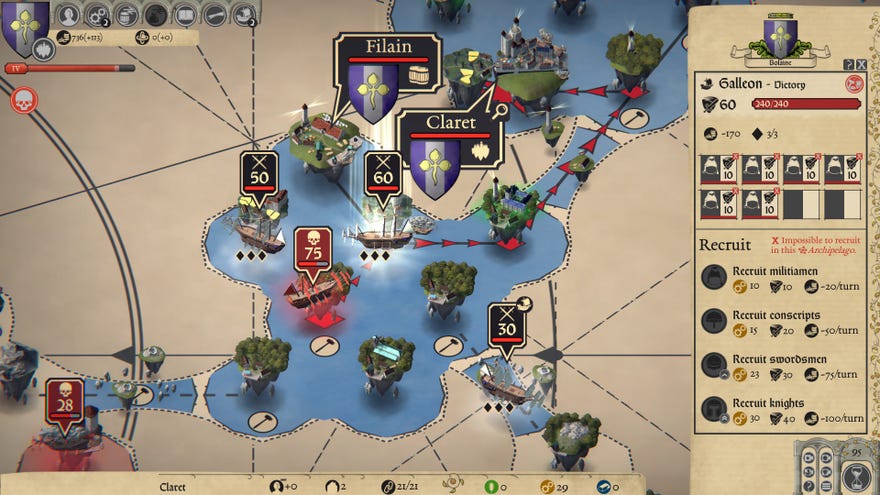The Rally Point: This year's low-intensity strategy for the Summer (?) heatwave (??) is Myriads: Renaissance
It’s the humidity that’ll get ya
It is once more that time of year when the searing heat drives us underground, to subsist on raw snacks, re-read The Book Of Phoenix, and play this year's Low-Intensity Strategy Game For When It's Actually Refreshingly Temperate And Rainy Out But We're Committed To The Bit Now.
Myriads Colon Renaissance is not quite the break from the 4X that I'd tried to get us, but it is a hybrid. You build up a city, explore and conquer new lands, unlock research and ultimately push everyone's faces in, but its other main pillar is tower defence, a genre I very rarely align with. Which is a good sign, right? Two good reasons not to choose it, but I am anyway.
The setting is fun too, if rather underutilised. It's a world of floating islands, traversed by airships in an otherwise roughly renaissance era setting. It naturally brings to mind Driftlands, a game I haven't played enough to offer much insight on. But rather than an RTS or typical tower defence, Myriads is turn-based, and instead of bringing together as landmass as possible, it has a rather curious structure with a light city building influence.
The world is floating islands, but each is divided into miniature archipelagos, forming regions that are separated by channels. Altogether it works more like a space game in that regard, with each island forming a square, and one in each region designated as suitable for settling. But your only true city is your capital. You can go there at any time, first to build farms, mines, and sawmills, and more specialised buildings once they're researched, each aiding expansion in some way, in a one-per-hex basis. Once in a while you can expand by building a tugboat that pulls in and attaches more land to the city, and figuring out the best way to expand this capital is as important as conquest.
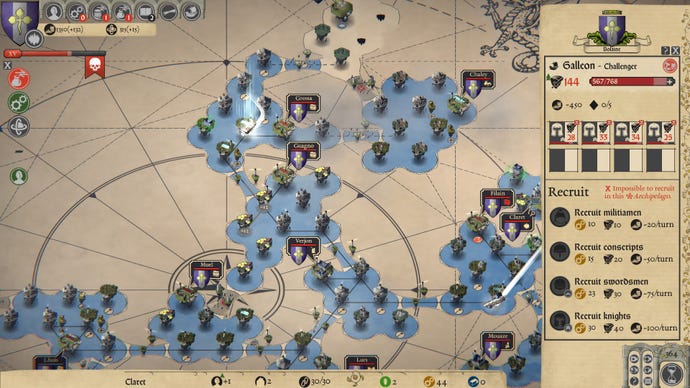
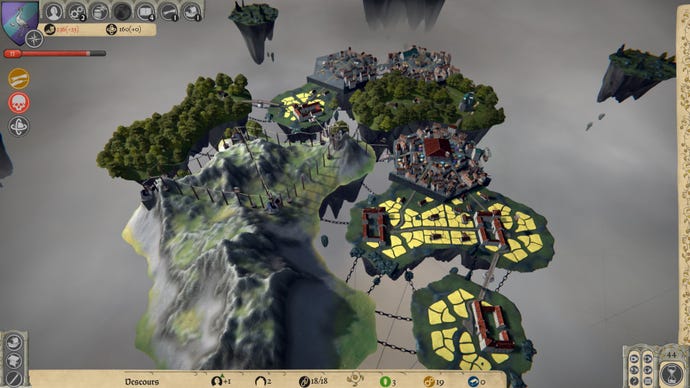
"Conquest" is perhaps inaccurate, since you're pretty much obliterating your enemies and building on the space left behind. Everyone's absolutely hostile, and rather than rival empires, you have one main foe that gets stronger over time and periodically sends out an attack to your capital, and lots of smaller enemies who send out smaller waves to hit your nearest colony instead. These can actually be more troublesome, since they react more directly to your expansion, rather than coming in predictable waves. So it's a guilt-free ride as you send out airships to take out raider bases, build colonies, and hopefully gather the gold and research needed to bump yourself up enough to meet the rising threat level, over and over until you're able to hit the enemy capital and win the game.
That final fight is typically easier than fending off the waves, which sounds a bit odd but reflects that this is a game about getting ahead of the curve rather than amassing a deathball. In fact you'll probably lose your first few games by building too big a military, or one too dispersed. There's only one military ship type in the game, the galleon, but rather than unlocking bigger ones or levelling things up, you fill each up with more recruits, adding to its attack power and health. Research unlocks conscripts, swordsmen, and eventually knights, who do the same job but more efficiently, cramming more attack power into each recruitment slot.
You'll probably lose a few games too, before realising that you ought to lean into the tower defence element. Raiders generally take a short path and thus should be attacked, but when the Catena send out a galleon or three, their incoming paths are marked, even long before you've uncovered the map. The islands you can't build cities on can often host a defensive tower that fires on passing enemies, and galleons and recruits are very expensive. So expensive, in fact, that it's sometimes better to let one sacrifice itself on a hopeless battle, to delay and weaken an invader, and to free up a massive amount of income that could, in several turns, buy another tower, an expensive one-off minefield, and then build and staff another galleon back at the capital. This is especially true once you unlock and build the merchant's guild, which converts production into gold if you stop building for a turn.
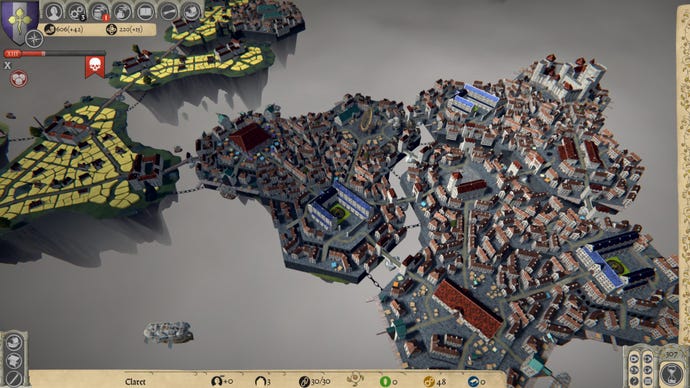
Managing this slightly unorthodox income and expense makes for an interesting challenge, both militarily and infrastructurally. The city building element isn't all that complex, but building space in the capital is extremely limited, even with all the relevant research unlocked. It might not even be the lategame before you're redeveloping your capital. In a surprisingly accurate reflection of historical colonialism, you'll gradually demolish farms and sawmills to replace them with factories, docks, and academies needed to provide the infrastructure to make your colonies productive, which in turn will replace and outproduce what you demolished back home. It means your capital is never really finished until the end game, by which point it's probably clear if you've won or not anyway and you're just running up to dropkick the enemy capital.
It sounds complicated, but it's never much to actually manage. Myriads is a heatwave game precisely because micromanagement is extremely out, and there are never too many decisions to make or possibilities to consider in any given turn. Even failure isn't a big deal. Although games can often fall into the 4X dynamic of being clearly hopeless after a few too many mistakes, it likely won't take very long to get there, and by the time it's hopeless there's little point dragging it out. You won't have built very much, thus there's not a lot to get overly attached to. Victory, meanwhile, isn't typically a foregone conclusion either. Each world's layout is randomised (with a seed listed if you like to replay them), which can actually make a pretty big difference given the importance of laying defensive lanes, how few galleons you can realistically field without crippling your economy and/or massively diluting your forces, and how much trouble even one corner full of unchecked raiders can cause if you don't prepare a way to protect your colonies.
This means that even quite late on, a sure thing can be rendered shaky by the need to scramble an exploratory galleon back to deal with a raider, or rebuild an ill-considered colony when you realised you've laid out your capital poorly and thus can't actually ship its produce home. There are three types of colony, see, and each must be researched. Defensive ones are relatively obvious; they can build more powerful towers and allow galleons to recruit, so should generally be set up in chokepoints. Exploitation colonies, though, ship raw resources home if you've built a big enough dock at the capital, and more still if you spend the gold to turn islands surrounding the colony into farms or mines.
Trading colonies are more complicated, and Myriads could use a more upfront and clear explanation of how they work and how much research and building the require; instead of food, they produce gold, but only if you've built a factory back home and a storehouse. I think the idea is the colony sells resources to the factory and the factory sells back processed goods, and rather than introduce lots of new resources the game just represents this abstractly as the colony producing money, but it's a bit confusing, especially since you're already shipping stuff from exploitation colonies to docks.
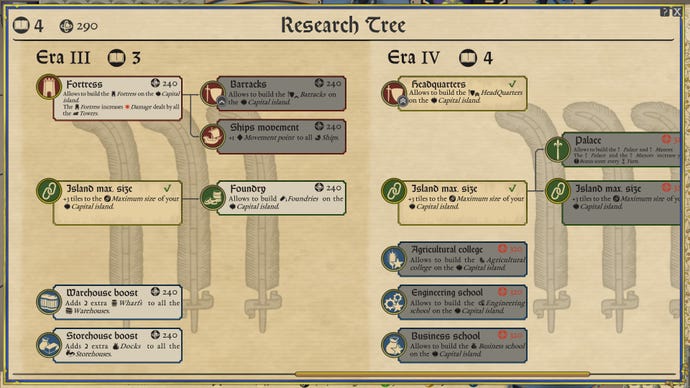
Fortunately on all but the hardest setting, there's room to make mistakes, and even build and bulldoze several times over before you get it right. You can fall behind a little and still catch up, and colony ships are cheap. Armies are expensive to maintain, but fast to train, making it often cheaper to raise them on demand like levies rather than having a standing navy if it isn't actively fighting at all times. Though there are treasure chests to gain from doing so, you may find yourself disbanding troops and kamikazeing galleons to save money instead, especially since most combat takes several turns (the outcomes are always certain and told to you upfront, again reducing the decision-making workload for your poor fried brain. Or soggy brain, depending on how this week turns out), and ongoing fights can be neither joined nor bypassed by uninvolved ships.
There's room for a few improvements. I wish it was clearer where towers and hospitals are once they're built, and what other requirements unlockable buildings have (eg the Headquarters requires 4 population to even build, which is probably way more than you can spare, making it a waste of research points until later). But these are far from insurmountable, and they're outweighed not just by its low-pressure design, but by its accompanying calm atmosphere. Its soundtrack is very limited, and there are only a few small sound effects (with an unnecessary, pleasant doppler effect when scrolling past a battle), but none of them ever get old.
Myriads never fully leans into the strengths of its component genres, but largely avoids their pitfalls too. It's not a game I'd champion as particularly revolutionary or exciting, but if you're looking to fill a few afternoons with a light strategic challenge that's more than piling numbers on each other, yet not overly demanding or elaborate, it hits exactly the right note whether you're sweating to death on the floor or nervously alt-tabbing to a map of the local floodplains.
